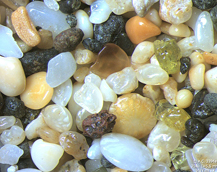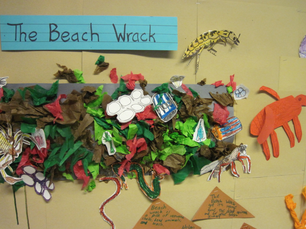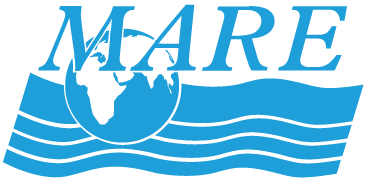2nd Grade–Sandy Beach

Download the Sandy Beach Teacher Guide Now
The MARE Teachers’ Guide to Sandy Beaches can be supplemented with the GEMS On Sandy Shores (available for purchase). The curriculum includes themes of the rock cycle, invertebrates and marine mammal adaptations.Download a possible instructional sequence, Thematic Instructional Sequence. (PDF, 79.6KB)
Curriculum Overview

It takes some detective work to “read” a sandy beach. Evidence of life is everywhere, but the actual life may be hard to find. Footprints, feathers, seaweed, shells, garbage, and oil may tell a story of who has visited a sandy beach. Even the shifting sands tell a story of formation, erosion and seasonal cycles of this coastal ecosystem.
Download MARE’s Teacher Background for the Sandy Beach (104KB, PDF).
Activity 1: Beach Bucket Scavenger Hunt (3 Sessions)
In this activity students are introduced to the vastness of our planet’s ocean and to the characteristics of one type of shoreline we call a beach. They work in small cooperative groups to explore a simulated sandy beach in a plastic tub that is littered with beach drift and debris. Through a sorting activity, they discover that biotic objects found on the sandy beach can be grouped into those that represent evidence of plant life, evidence of animal life and evidence of humans. They discover the differences between abiotic and biotic objects.
Activity 2: Sand On Stage (4 Sessions)

Students use hand lenses or microscopes to compare the color, size, and shape of several sand samples. They then use rock and mineral kits and magnets and perform tests to guess about the origin and composition of “their” sample. They record their findings on a student sheet and then draw a sequence of pictures of how the sand they examined might have been formed and what the beach looked like where it was collected.
Activity 3: Hermit Crabs In The Classroom (3 Sessions)
Students construct temporary homes for visiting hermit crabs. They become student scientists while making guided observations, and biological illustrators while sketching their crabs. Students then help create a permanent home for the hermit crabs and learn about the care of these animals.
Activity 4: Shell Sorting (3 Sessions)
Students explore shell collections and shell reference books, and then work with a partner to answer a series of guided questions about shelled animals including what they want to know about shells and the animals that make them. They then work in cooperative groups to decide creatively how to sort a basket of shells into categories related to each other in some way. Each student in the group then picks one of the categories to illustrate and name. Students from each group have the opportunity to visit each other’s shell museum and guess what criteria the groups based their categories on. This session ends with more specific information about the shelled organisms, including how scientists classify them.
Activity 5: Ears To You (3 Sessions)
Students work cooperatively to teach each other about the adaptations that seals and sea lions have for living in the ocean, and about the differences between seals and sea lions. Then students participate in a game show to check for understanding.
Activity 6: Build A Sandy Beach (5 Sessions)

This activity transforms your classroom into a sandy beach habitat as the students construct 3-dimensional, magnified models of organisms that live below the sand as well as models of the living and dead organisms that make up the beach wrack washed ashore by the waves. Student presentations and two games, Who am I? and Twenty Questions, reinforce growing student knowledge about sandy beach organisms, their interactions and their habitat.

